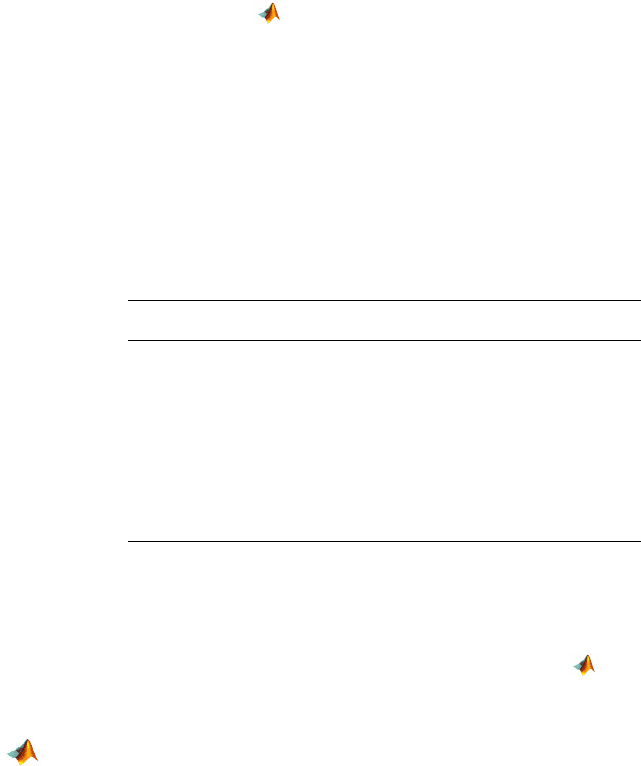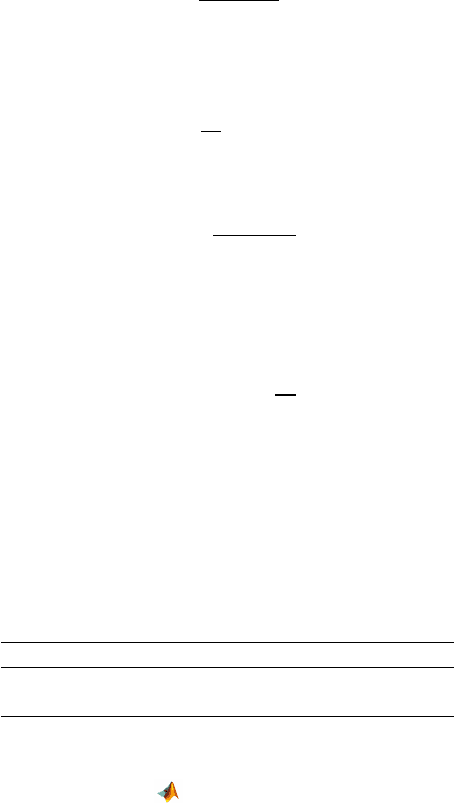Vidakovic B. Statistics for Bioengineering Sciences: With Matlab and WinBugs Support
Подождите немного. Документ загружается.


11.10 Gauge R&R ANOVA* 449
proaches have become widely accepted: (i) the average and range method, also
known as the AIAG method, and (ii) the ANOVA method. We will focus on
the ANOVA method and direct interested readers to Montgomery (2005) for
comprehensive coverage of the topic.
In a typical gauge R&R study, several operators measure the same parts in
random order. Most studies involve two to five operators and five to ten parts.
There are usually several trial repetitions, which means that an operator per-
forms multiple measurements on the same part.
The ANOVA method of analyzing measurement data provides not only
the estimates for repeatability or equipment variation, reproducibility or ap-
praiser variation, and part-to-part variation, but also accounts for possible
interaction components.
We first define several key terms in gauge R&R context.
Gauge or gage: Any device that is used to obtain measurements.
Part: An item subjected to measurement. Typically a part is selected at
random from the entire operating range of the process.
Trial: A set of measurements on a single part that is taken by an opera-
tor.
Measurement system: The complete measuring process involving
gauges, operators, procedures, and operations. The system is evaluated
as capable, acceptable, and not capable depending on the variabilities of
its components. Notions of repeatability, reproducibility (R&R), and part
variability as the main sources of variability in a measurement system
are critical for its capability assessment.
Repeatability: The variance in measurements obtained with a measur-
ing instrument when used several times by an appraiser while measur-
ing the identical characteristic on the same part.
Reproducibility: The variation in measurements made by different ap-
praisers using the same instrument when measuring an identical char-
acteristic on the same part.
The measurements in a gauge R&R experiment are described as an ANOVA
model
y
i jk
=µ +P
i
+O
j
+PO
i j
+²
i jk
, i =1,..., p; j =1,... , o; k =1,..., n,
where P
i
, O
i
, PO
i j
, and ²
i jk
are independent random variables that represent
the contributions of parts, operators, part–operator interaction, and random
error to the measurement. We assume that the design is balanced, that there

450 11 ANOVA and Elements of Experimental Design
are p parts and o operators, and that for each part/operator combination there
are n trials.
This is an example of a random effect, two-way ANOVA, since the factors
parts and operators are both randomly selected from the population consisting
of many parts and operators. Except for the grand mean
µ, which is considered
a constant, the random variables P
i
, O
j
, PO
i j
, ²
i jk
are considered independent
zero-mean normal with variances
σ
2
P
, σ
2
O
, σ
2
PO
, and σ
2
. Then the variability of
measurement y
i jk
splits into the sum of four variances:
Var (y
i jk
) =σ
2
P
+σ
2
O
+σ
2
PO
+σ
2
.
As in Sect. 11.3, the mean squares in the ANOVA table are obtained as
MSP
=
SSP
p −1
, MSO
=
SSO
o −1
, MSPO
=
SSPO
(p −1)(o −1)
, MSE
=
SSE
po(n −1)
,
where the sums of squares are standardly defined (p. 425). Since this is a
random-effect ANOVA, one can show that
E(MSP) = σ
2
+nσ
2
PO
+onσ
2
P
,
E(MSO) = σ
2
+nσ
2
PO
+ pnσ
2
O
,
E(MSPO) = σ
2
+nσ
2
PO
,
E(MSE) = σ
2
.
The derivation of these expectations is beyond the scope of this text, but a
thorough presentation of it can be found in Montgomery (1984) or Kutner et
al. (2005). The above expectations, by moment matching, lead to the estimates
ˆ
σ
2
P
=
MSP −MSPO
on
,
ˆ
σ
2
O
=
MSO −MSPO
pn
,
ˆ
σ
2
PO
=
MSPO −MSE
n
,
ˆ
σ
2
= MSE.
In the context of R&R analysis, the definitions of empirical variance compo-
nents are as follows:

11.10 Gauge R&R ANOVA* 451
ˆ
σ
2
Re peat
=
ˆ
σ
2
ˆ
σ
2
Re prod
=
ˆ
σ
2
O
+
ˆ
σ
2
PO
ˆ
σ
2
Gauge
=
ˆ
σ
2
Re peat
+
ˆ
σ
2
Re prod
=
ˆ
σ
2
+
ˆ
σ
2
O
+
ˆ
σ
2
PO
ˆ
σ
2
Total
=
ˆ
σ
2
Gauge
+
ˆ
σ
2
Part
Next we provide several measures of the capability of a measurement sys-
tem.
Number of Distinct Categories. The measure called signal-to-noise ratio,
in the context of R&R, is defined as
SNR
=
v
u
u
t
2 ×
ˆ
σ
2
Part
ˆ
σ
2
Gauge
.
The SNR rounded to the closest integer defines the NDC measure, which is a
resolution of the measurement system.
The NDC informally indicates how many “categories” the measurement
system is able to differentiate. If NDC
=0 or 1, then the measurement system
is useless. If NDC
= 2, then the system can differentiate only between two
categories (“small” and “large,” in T-shirt terminology). If NDC
= 3, then the
system can distinguish “small,” “medium,” and “large,” and so on. If NDC
≥5,
then the measurement system is capable. If NDC
≤1, then the measurement
system is not capable. Otherwise, the measurement system is evaluated as
acceptable.
Percent of R&R Variability. The percent of R&R variability (PRR) mea-
sures the size of the R&R variation relative to the total data variation. It is
defined as
PRR
=
v
u
u
t
ˆ
σ
2
Gauge
ˆ
σ
2
Total
.
If PRR
<10%, then the measurement system is capable. If PRR >30%, the
measurement system is not capable; the system is acceptable for 10%
≤PRR ≤
30%. Also, the individual contribution of repeatability and reproducibility
variances entering the summary measure PRR are of interest. For instance,
a large repeatability variation, relative to the reproducibility variation, indi-

452 11 ANOVA and Elements of Experimental Design
cates a need to improve the gauge. A high reproducibility variance relative to
repeatability indicates a need for better operator training.
MATLAB’s function
gagerr(y,part,operator) performs a gauge repeata-
bility and reproducibility analysis on measurements in vector
y collected by
operator on part. As in the anovan command, the number of elements in part
and operator should be the same as in y. There are many important options in
gagerr, and we recommend that the user carefully consult the function help.
Example 11.14. Measurements of Thermal Impedance. This example of
a gauge R&R study comes from Houf and Berman (1988) and Montgomery
(2005). The data, in the table below, represent measurements on thermal
impedance (in
◦
C per Watt × 100) on a power module for an induction mo-
tor starter. There are ten parts, three operators, and three measurements per
part.
Part Operator 1 Operator 2 Operator 3
number Test 1 Test 2 Test 3 Test 1 Test 2 Test 3 Test 1 Test 2 Test 3
1 37 38 37 41 41 40 41 42 41
2 42 41 43 42 42 42 43 42 43
3 30 31 31 31 31 31 29 30 28
4 42 43 42 43 43 43 42 42 42
5 28 30 29 29 30 29 31 29 29
6 42 42 43 45 45 45 44 46 45
7 25 26 27 28 28 30 29 27 27
8 40 40 40 43 42 42 43 43 41
9 25 25 25 27 29 28 26 26 26
10 35 34 34 35 35 34 35 34 35
Using ANOVA R&R analysis evaluate the capability of the measurement
system by assuming that parts and operators possibly interact. See Exer-
cise 11.27 for the case where parts and operators do not interact (additive
ANOVA model).
We will first analyze the problem as a two-way ANOVA (
RandR2.m) and
then, for comparison, provide MATLAB’s output from the function
gagerr.
%model with interaction
impedance = [...
37 38 37 41 41 40 41 42 41 42 41 43 42 42 42 43 42 43 ...
30 31 31 31 31 31 29 30 28 42 43 42 43 43 43 42 42 42 ...
28 30 29 29 30 29 31 29 29 42 42 43 45 45 45 44 46 45 ...
25 26 27 28 28 30 29 27 27 40 40 40 43 42 42 43 43 41 ...
25 25 25 27 29 28 26 26 26 35 34 34 35 35 34 35 34 35]’ ;
% forming part and operator vectors.
a = repmat([1:10],9,1); part = a(:);
b = repmat([1:3], 3,1); operator = repmat(b(:),10,1);
[p table stats terms] = anovan( impedance,{part, operator},...
’model’,’interaction’,’varnames’,{’part’,’operator’} )

11.10 Gauge R&R ANOVA* 453
MSE = table{5,5} %0.5111
MSPO =table{4,5} %2.6951
MSO = table{3,5} %19.6333
MSP = table{2,5} %437.3284
p = stats.nlevels(1); o = stats.nlevels(2);
n=length(impedance)/(p
*
o);%p=10, 0=3, n=3
s2Part = (MSP - MSPO)/(o
*
n) %48.2926
s2Oper = (MSO - MSPO)/(p
*
n) %0.5646
s2PartOper = (MSPO - MSE)/n %0.7280
s2 = MSE %0.5111
s2Repeat = s2 %0.5111
s2Repro = s2Oper + s2PartOper %1.2926
s2Gage = s2Repeat + s2Repro %1.8037
s2Tot = s2Gage + s2Part %50.0963
%percent variation due to part
ps2Part = s2Part/s2Tot %0.9640
% signal-to-noise ratio; > 5 measuring system is capable
snr = sqrt( 2
*
ps2Part/(1-ps2Part)) %7.3177
% snr rounded is NDC (number of distinct categories).
ndc = round(snr) %7
% percent of R&R variability
prr = sqrt(s2Gage/s2Tot) %0.1897
Therefore, the measuring system is capable by NDC =7 ≥5 but falls in the
“gray” zone (10, 30) according to the PRR measure.
MATLAB’s built-in function
gagerr produces a detailed output:
gagerr(impedance,{part, operator},’model’,’interaction’)
% Source Variance %Variance sigma 5.15
*
sigma 5.15
*
sigma
% ================================================================
% Gage R&R 1.80 3.60 1.34 6.92 18.97
% Repeatability 0.51 1.02 0.71 3.68 10.10
% Reproducibility 1.29 2.58 1.14 5.86 16.06
% Operator 0.56 1.13 0.75 3.87 10.62
% Part
*
Operator 0.73 1.45 0.85 4.39 12.05
% Part 48.29 96.40 6.95 35.79 98.18
% Total 50.10 100.00 7.08 36.45
% ----------------------------------------------------------------
% Number of distinct categories (NDC) : 7
% % of Gage R&R of total variations (PRR): 18.97
When operators and parts do not interact, an additive ANOVA model,
y
i jk
=µ +P
i
+O
j
+²
i jk
, i =1,..., p; j =1,... , o; k =1,..., n,

454 11 ANOVA and Elements of Experimental Design
should be used. In this case, the estimators of variances are
ˆ
σ
2
P
=
MSP −MSE
on
,
ˆ
σ
2
O
=
MSO −MSE
pn
,
ˆ
σ
2
= MSE,
and
ˆ
σ
2
Re prod
is simply reduced to
ˆ
σ
2
O
.
Exercise 11.27 solves the problem in Example 11.14 without the PO-
interaction term and compares the analysis with the output from
gagerr.
11.11 Testing Equality of Several Proportions
An ANOVA-type hypothesis can be considered in the context of several pro-
portions. Consider k independent populations from which k samples of size
n
1
, n
2
,... , n
k
are taken. We record a binary attribute, say, 1 or 0. Let X
1
, X
2
,... ,
X
k
be the observed number of 1s and
ˆ
p
1
= X
1
/n
1
,... ,
ˆ
p
k
= X
k
/n
k
the sample
proportions.
To test H
0
: p
1
= p
2
=··· = p
k
against the general alternative H
1
= H
c
0
, the
statistic
χ
2
=
k
X
i=1
(X
i
−n
i
p)
2
n
i
p(1 − p)
is formed. Here
p =
X
1
+X
2
+···+X
k
n
1
+n
2
+···+n
k
is a pooled sample proportion (under H
0
all proportions are the same and
equal to p, and
p is the best estimator). The statistic χ
2
has a χ
2
-distribution
with k
−1 degrees of freedom.
If H
0
is rejected, a Marascuillo procedure (Marascuillo and Serlin, 1988)
can be applied to compare individual pairs of population proportions. For k
populations there are k(k
−1)/2 tests, and the two proportions p
i
and p
j
are
different if
|
ˆ
p
i
−
ˆ
p
j
|>
q
χ
2
k
−1,1−α
×
q
ˆ
p
i
(1 −
ˆ
p
i
)/n
i
+
ˆ
p
j
(1 −
ˆ
p
j
)/n
j
. (11.13)
Example 11.15. Gender and Hair Color. Zar (1996, p. 484) provides data on
gender proportions in samples of subjects grouped by the color of their hair.

11.12 Testing the Equality of Several Poisson Means* 455
Hair color
Gender Black Brown Blond Red
Male 32 43 16 9
Female 55 65 64 16
Total 87 108 80 25
We will test the hypothesis that population proportions of males are the same
for the four groups.
%Gender Proportions and Hair Color
Xi = [32 43 16 9];
ni = [87 108 80 25];
pi = Xi./ni %0.3678 0.3981 0.2000 0.3600
pbar = sum(Xi)/sum(ni) %0.3333
chi2 = sum( (Xi - ni
*
pbar).^2./(ni
*
pbar
*
(1-pbar)) ) %8.9872
pval = 1-chi2cdf(chi2, 4-1) %0.0295
Thus, with p-value of about 3%, the hypothesis of homogeneity of popu-
lation proportions is rejected. Using the condition in (11.13) show that the
difference between
ˆ
p
2
and
ˆ
p
3
is significant and responsible for rejecting H
0
.
Remark. We will se later (Chap. 14) that this test and the test for homo-
geneity in 2
×c contingency tables are equivalent. Here we assumed that the
sampling design involved fixed totals n
i
. If the sampling was fully random (i.e.,
no totals for hair color nor males/females were prespecified) then H
0
would be
the hypothesis of independence between gender and hair color.
For Tukey-type multiple comparisons and testing proportion trends, see
Zar (1996) and Conover (1999).
11.12 Testing the Equality of Several Poisson Means*
When in each of k treatments observations are multiple counts, the standard
ANOVA is often inappropriately applied to test for the equality of means. For
counting observations the Poisson model is more adequate than the normal,
and using a standard ANOVA methodology may be problematic. For example,
when an ANOVA hypothesis of equality of means is rejected, but the observa-
tions are in fact Poisson, multiple comparisons may be invalid due to unequal
treatment variances (which for Poisson observations are equal to the means).
Next, we describe an approach that is appropriate for Poisson observations.
Suppose that in treatment i we observe n
i
Poisson counts,
X
i j
∼P oi(λ
i
), i =1, . .., k; j =1,.. . , n
i
.

456 11 ANOVA and Elements of Experimental Design
Denote by O
i
the sum of all counts in treatment i, O
i
=
P
n
i
j=1
X
i j
, and by O
the sum of counts across all treatments, O
=
P
k
i
=1
O
i
. The total number of
observations is N
=
P
k
i
=1
n
i
.
One can show that the distribution of the vector (O
1
,O
2
,... , O
k
), given the
total sum O, is multinomial (p. 155),
(
O
1
,O
2
,... , O
k
|O
)
∼M n(O, p),
where p
=(p
1
, p
2
,... , p
k
) is defined via
p
i
=
n
i
λ
i
P
k
i
=1
n
i
λ
i
.
Thus, when the hypothesis H
0
: λ
1
=λ
2
=···=λ
k
is true, then p
i
= n
i
/N.
Suppose that counts O
i
are observed. Define expected counts E
i
as
E
i
= p
i
×O =
n
i
N
×O, i =1,..., k.
Then
χ
2
=
k
X
i=1
(O
i
−E
i
)
2
E
i
is Pearson’s test statistic for testing H
0
. When H
0
is true, it has an approx-
imately
χ
2
-distribution with k −1 degrees of freedom. Alternatively, one can
use the likelihood statistic
G
2
=2
k
X
i=1
O
i
log
O
i
E
i
,
which under H
0
has the same distribution as the χ
2
. Large values of χ
2
or G
2
are critical for H
0
.
Example 11.16. Assume that in an experiment three treatments are applied
on 20 plates populated with a large number of cells, the first treatment on 7,
the second on 5, and the third on 8 plates.
The following table gives the numbers of cells per plate that responded to
the treatments.
Treatment 1 Treatment 2 Treatment 3
1 6 4 2 3 5 5 9 2 7 2 3 0 2 1
8 2 4 5 2
We assume a Poisson model and wish to test the equality of mean counts,
H
0
: λ
1
= λ
2
=λ
3
.
The solution is provided in
poissonmeans.m. The hypothesis of the equal-
ity of means is rejected with a p-value of about 1.3%. Note that standard

11.13 Exercises 457
ANOVA fails to reject H
0
, for the p-value is 6.15%. This example demonstrates
the inadequacy of standard ANOVA for this kind of data.
ncells = [1 6 4 2 3 8 2 5 5 9 2 7 2 3 0 2 1 4 5 2]’;
agent = [1 1 1 1 1 1 1 2 2 2 2 2 3 3 3 3 3 3 3 3]’;
ncells1=ncells(agent==1)
ncells2=ncells(agent==2)
ncells3=ncells(agent==3)
k = 3; %treatments
n1 = length(ncells1); n2 = length(ncells2); n3= length(ncells3);
ni=[n1 n2 n3] %7 5 8
N = sum(ni) %20
O1 = sum(ncells1); O2 = sum(ncells2); O3 = sum(ncells3);
Oi=[O1 O2 O3] %26 28 19
O = sum(Oi) %73
%expected
Ei = O .
*
ni/N %25.55 18.25 29.2
%Poisson chi2
chi2 = sum( (Oi - Ei).^2 ./ Ei ) %8.7798
%Likelihood G2
G2 = 2
*
sum( Oi .
*
log(Oi./Ei ) ) %8.5484
pvalchi2 = 1 - chi2cdf(chi2, k-1) %0.0124
pvalG2 = 1 - chi2cdf(G2, k-1) %0.0139
% If the problem is treated as ANOVA
[panova table] = anova1(ncells, agent)
% panova = 0.0615
% table =
% ’Source’ ’SS’ ’df’ ’MS’ ’F’ ’Prob>F’
% ’Groups’ [ 32.0464] [ 2] [16.0232] [3.3016] [0.0615]
% ’Error’ [ 82.5036] [17] [ 4.8532] [] []
% ’Total’ [114.5500] [19] [] [] []
11.13 Exercises
11.1. Nematodes. Some varieties of nematodes (roundworms that live in the
soil and are frequently so small that they are invisible to the naked eye)
feed on the roots of lawn grasses and crops such as strawberries and toma-
toes. This pest, which is particularly troublesome in warm climates, can be
treated by the application of nematocides. However, because of the size of
the worms, it is very difficult to measure the effectiveness of these pesti-
cides directly. To compare four nematocides, the yields of equal-size plots of
one variety of tomatoes were collected. The data (yields in pounds per plot)
are shown in the table.

458 11 ANOVA and Elements of Experimental Design
Nematocide A Nematocide B Nematocide C Nematocide D
18.6 18.7 19.4 19.0
18.4 19.0 18.9 18.8
18.4 18.9 19.5 18.6
18.5 18.5 19.1 18.7
17.9 18.5
(a) Write a statistical model for ANOVA and state H
0
and H
1
in terms of
your model.
(b) What is your decision if
α =0.05?
(c) For what values of
α will your decision be different than that in (b)?
11.2. Cell Folate Levels in Cardiac Bypass Surgery. Altman (1991, p. 208)
provides data on 22 patients undergoing cardiac bypass surgery. The pa-
tients were randomized to one of three groups receiving the following treat-
ments:
Treatment 1. Patients received a 50% nitrous oxide and 50% oxygen mix-
ture continuously for 24 hours.
Treatment 2. Patients received a 50% nitrous oxide and 50% oxygen mix-
ture only during the operation.
Treatment 3. Patients received no nitrous oxide but received 35 to 50%
oxygen for 24 hours.
The measured responses are red cell folate levels (ng/ml) for the three
groups after 24 hours of ventilation.
Treat1 243 251 275 291 347 354 380 392
Treat2 206 210 226 249 255 273 285 295 309
Treat3 241 258 270 293 328
The question of interest is whether the three ventilation methods result in
a different mean red cell folate level.
If the hypothesis of equality of treatment means is rejected, which means
are significantly different?
11.3. Computer Games. In Exercise 7.22, Mental Rotations Test scores were
provided for three groups of children:
Group 1 (“Factory” computer game):
X
1
=22.47, s
1
=9.44, n
1
=19.
Group 2 (“Stellar” computer game):
X
2
=22.68, s
2
=8.37, n
2
=19.
Control (no computer game):
X
3
=18.63, s
3
=11.13, n
3
=19.
Assuming a normal distribution of scores in the population and equal pop-
ulation variances, test the hypothesis that the population means are the
same at a 5% significance level.
11.4. MTHFR C677T Genotype and Levels of Homocysteine and Folate.
A study by Ozturk et al. (2005) considered the association of methylenete-
trahydrofolate reductase (MTHFR) C677T polymorphisms with levels of ho-
mocysteine and folate. A total of N
=815 middle-aged and elderly subjects
